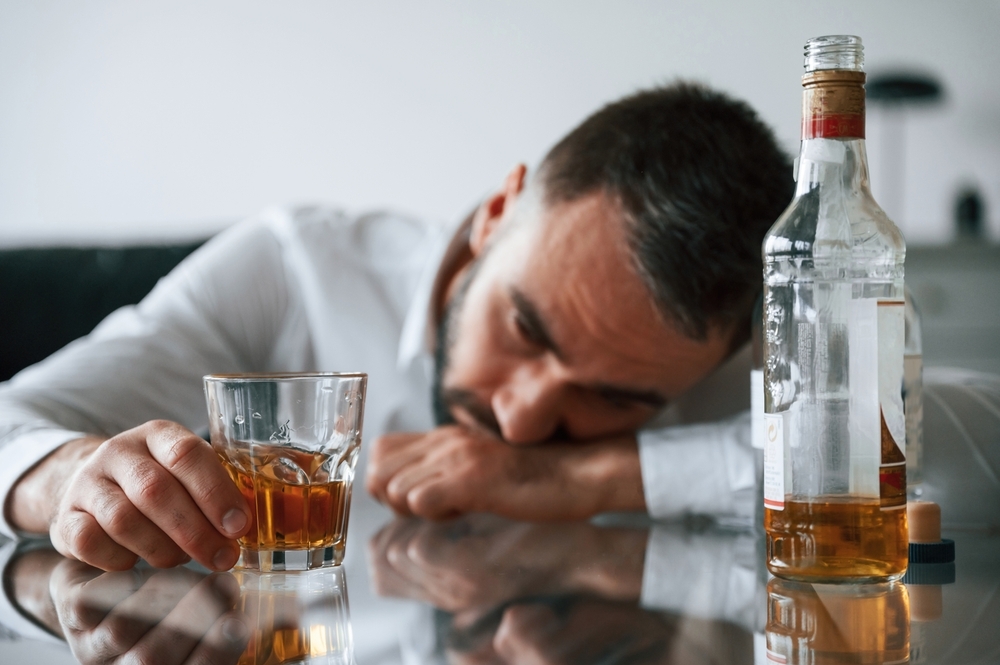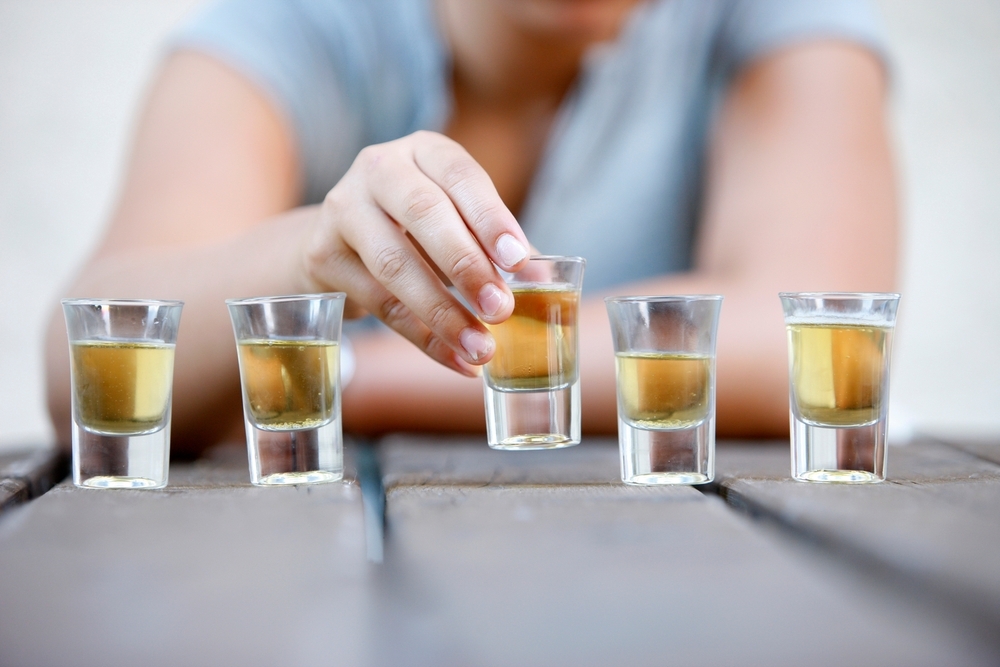
Written by:
Last Updated:
October 29th, 2025
As the Roman philosopher Marcus Tullius Cicero once said, “The face is a picture of the mind as the eyes are its interpreter.” Our faces often reveal more than we realise, especially when it comes to long-term alcohol misuse. While no single feature confirms alcoholism, certain physical signs can indicate its effects on the body. In this guide, we’ll explore the facial signs of alcohol addiction, why they occur and how to distinguish them from other conditions.

What exactly is an ‘alcoholic face’?
An alcoholic face refers to the way long-term alcohol misuse can change a person’s appearance. It often shows up as persistent redness, puffiness or visible blood vessel damage, giving the skin a flushed or uneven look.
But an alcoholic face goes further than just aesthetics as these changes can be a sign of deeper health problems, like high blood pressure or organ strain. While not everyone who drinks heavily will show these signs, they can be a clue that alcohol is having an impact on the body.
Can ‘alcoholic face’ appear after short-term drinking?
Alcohol can affect your appearance even after a short period of heavy drinking. While long-term alcohol misuse leads to more permanent facial changes, short-term drinking can cause noticeable but often temporary effects. These changes may not be as severe but they can still reflect how alcohol impacts the body.
Flushed or red face
One of the most common short-term effects of drinking is facial redness. This happens because alcohol dilates blood vessels, increasing blood flow to the skin.
Puffiness and swelling
Alcohol causes dehydration, which triggers the body to retain water in response. This can lead to facial bloating, particularly around the eyes and cheeks. Even after just one night of drinking, some people wake up with a swollen or puffy face, which can take hours or even a full day, to subside.
Dark circles and tired appearance
Alcohol disrupts sleep patterns, reducing the quality of rest. Even if a person sleeps for a full night after drinking, the body doesn’t go through its proper restorative sleep cycles, leading to a fatigued, dull appearance the next day. This often presents as dark under-eye circles, a tired expression and dry, lacklustre skin.
Dehydrated and dull skin
Alcohol is a diuretic, meaning it increases urine production and removes fluids from the body. As a result, the skin can become dry, tight and less elastic, making fine lines and wrinkles appear more pronounced. Short-term drinking can also make the skin look dull or uneven due to dehydration and reduced circulation.
Bloodshot eyes
Alcohol expands blood vessels in the eyes, leading to redness and irritation. Combined with poor sleep and dehydration, this can give a person a worn-out, heavy-lidded look. Bloodshot eyes are a common and immediate sign of alcohol consumption, often lingering the morning after drinking.
How long do these short-term effects last?
Most of these signs fade once alcohol is fully processed by the body, typically within 24 to 48 hours, depending on factors such as hydration levels and overall health. However, frequent binge drinking can make these effects last longer or cause more concerning issues.
Alcoholic face in long-term alcoholism
Chronic alcohol consumption can lead to lasting changes in a person’s facial appearance. Unlike the temporary effects of short-term drinking, these changes develop over time and may not fully reverse even after sobriety.
Persistent facial redness
One of the most recognisable signs of long-term alcohol misuse is ongoing facial redness, particularly around the cheeks and nose. Alcohol causes blood vessels to expand and repeated dilation over time can lead to permanently broken capillaries, known as telangiectasia. This results in a flushed or blotchy complexion that doesn’t fade, even after periods of sobriety.
Dry and prematurely aged skin
Alcohol depletes essential nutrients, including vitamins A and C, which are important for skin repair and elasticity. Over time, this leads to dry, rough and sagging skin, with wrinkles becoming more pronounced. Since alcohol also reduces collagen production, the face may take on a hollow or sunken look, particularly around the cheeks and under the eyes. This premature ageing effect is often more pronounced in long-term drinkers.
Jaundice and yellowing skin
Severe liver damage from alcohol misuse can result in jaundice, a condition where the skin and eyes take on a yellowish tint. This occurs when the liver struggles to process bilirubin, a substance produced by the breakdown of red blood cells. Jaundice is a serious sign of liver dysfunction and often indicates conditions like alcoholic hepatitis or cirrhosis.
Broken blood vessels and ‘alcoholic nose’
Chronic alcohol use can cause rosacea, a skin condition characterised by persistent redness and visible blood vessels. In some cases, alcohol misuse contributes to rhinophyma, an extreme form of rosacea that leads to a thickened, bulbous nose with enlarged pores and prominent veins. While rhinophyma can develop without alcohol consumption, it is strongly associated with heavy drinking and is often referred to as ‘alcoholic nose’ or ‘drinker’s nose’.
Hollow or gaunt appearance
While some long-term drinkers experience bloating, others may develop a sunken, gaunt look due to poor nutrition. Chronic alcohol consumption often leads to malnutrition, as alcohol interferes with the absorption of key nutrients and reduces appetite. This can cause muscle and fat loss in the face, making the cheekbones more prominent and the skin appear thin and fragile.
Dark circles and a perpetually tired look
Alcohol disrupts sleep quality but in long-term alcoholism, chronic fatigue and sleep deprivation become more apparent in facial features. Dark circles become more pronounced, the whites of the eyes may appear dull or slightly yellowed and the skin can take on a permanently fatigued appearance.
Do these signs always mean that the person is an alcoholic?
The physical signs associated with an alcoholic face do not always mean that someone has an alcohol addiction. It can also be linked to other medical conditions and lifestyle factors. Below, we take a look at some of these factors:.
Other causes of facial redness and broken blood vessels
- Rosacea: A chronic skin condition that causes persistent redness and visible blood vessels, often mistaken for signs of alcohol use.
- Bulging veins: A condition that can cause veins across the body to appear on the surface of the skin. It is not always linked to heavy alcohol use.
- Extreme temperatures and sun exposure: Can damage blood vessels, leading to permanent redness.
Other causes of puffiness and swelling
- Liver disease unrelated to alcohol: Conditions like non-alcoholic fatty liver disease (NAFLD) can cause water retention and facial swelling.
- Kidney problems: Impaired kidney function can lead to fluid buildup in the face and body.
- Dietary factors: High salt intake can cause temporary bloating and puffiness.
Other causes of a gaunt or prematurely aged appearance
- Weight loss and malnutrition: Not eating enough or absorbing nutrients properly can cause hollow cheeks and sagging skin.
- Smoking: Reduces collagen and elastin in the skin, leading to premature wrinkles.
- Chronic stress and poor sleep: Can contribute to dark circles, dull skin and a permanently tired look.
How to differentiate alcohol-related facial changes
While one or two of these symptoms alone don’t confirm alcoholism, a combination of multiple facial signs, along with other behavioural and physical symptoms, may suggest chronic alcohol misuse. These additional signs can include:
- Frequent bloodshot eyes
- Tremors or shaky hands
- Strong alcohol smell on breath even in the morning
- Repeated health issues linked to alcohol, such as digestive problems or high blood pressure
Remember, while we aim to provide insight into potential alcohol addiction signs, only a professional assessment can determine if someone has an alcohol problem.
I’m worried my loved one has an issue with alcohol
If your loved one has shown signs of an alcoholic face, it may be a sign that their body is struggling to cope with the effects of alcohol. If you’re concerned about their health and well-being, seeking help with alcohol is an important step.
At Sanctuary Lodge, we understand how difficult it can be to watch someone battle alcohol addiction. Our alcohol rehab programme provides a safe and structured environment where individuals can break free from the cycle of alcoholism and rebuild their health. With expert medical care, therapy and holistic treatments, we offer personalised support to address both the physical and emotional aspects of addiction.
If you’re looking for alcohol help for a loved one, Sanctuary Lodge is here to guide them towards recovery. Reach out today to learn how we can help them take the first step towards a healthier future.
(Click here to see works cited)
- “Rhinophyma: Causes and Treatment.” WebMD, WebMD, www.webmd.com/skin-problems-and-treatments/what-to-know-about-rhinophyma. Accessed 13 Feb. 2025.
- “Rosacea: Symptoms, Causes, Triggers & Treatment.” Cleveland Clinic, 6 Feb. 2025, my.clevelandclinic.org/health/diseases/12174-rosacea.
- “Bulging Veins: Causes, Symptoms and Treatment.” Cleveland Clinic, 7 Feb. 2025, my.clevelandclinic.org/health/diseases/22877-bulging-veins.
- “Kidney Disease: Can It Cause Itchy Skin and Rashes?” Medical News Today, MediLexicon International, www.medicalnewstoday.com/articles/rash-kidney-disease-itchy-skin. Accessed 13 Feb. 2025.“Are You Eating Too Much Salt?” WebMD, WebMD, www.webmd.com/diet/ss/slideshow-too-much-salt. Accessed 13 Feb. 2025.




